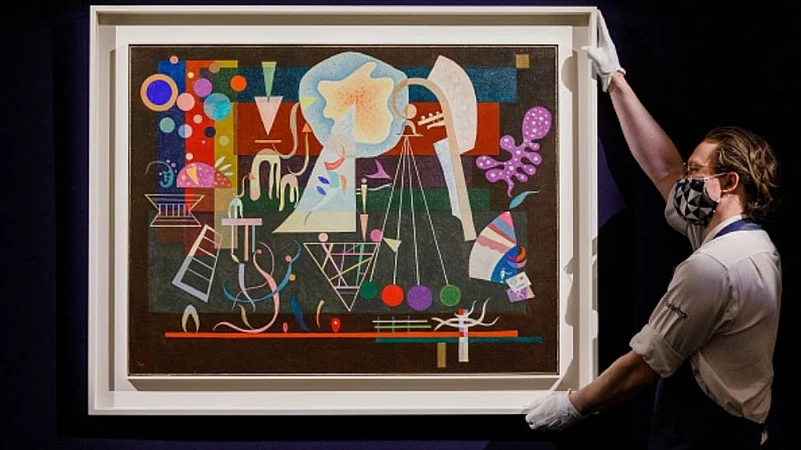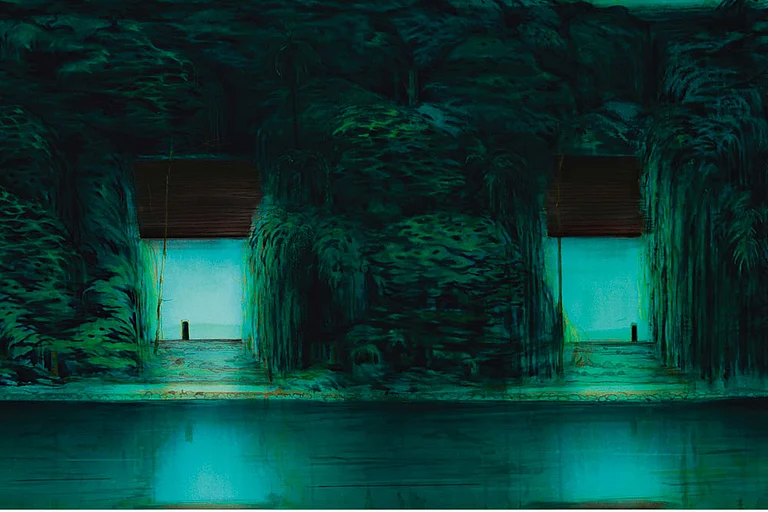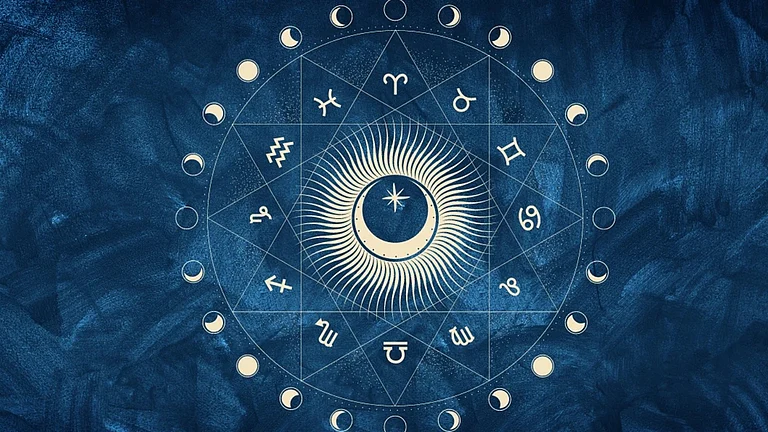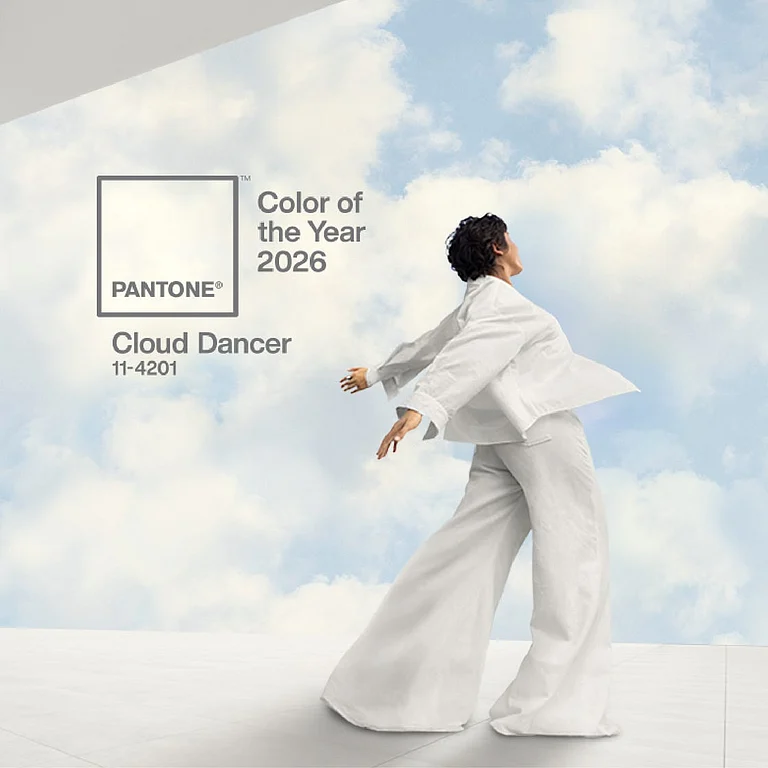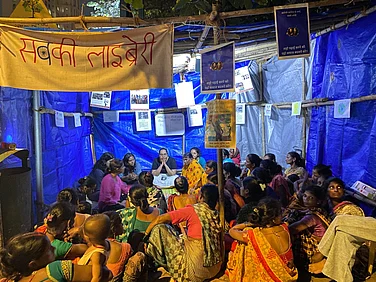For two weeks in September 2020, I saw my daughter, S, trying out her school art teacher’s prompt: attempting Wassily Kandinsky’s synaesthetic technique of giving shape and colour to music. The piece that was given to them to do this exercise was Beethoven’s ‘Moonlight Sonata’, which she listened to on loop while working. Never mind that most of the drawing happened in quiet afternoons, with bright sunlight illuminating both the artist and her work.
I had seen few assignments that had invigorated her as much in the previous 18 Covid months. The last I could think of was another art assignment, the previous summer when they were taught the Pointillist style.
Wassily Kandinsky
We watched the video on Kandinsky that her teacher had uploaded for reference twice together. “For Kandinsky, every colour had a feeling, a sensation, and a sound”, the narrative explained. The colours corresponded to instruments in his mind: warm red to “trumpets — strong, harsh and ringing”; cool red to the “sad, middle tones of a cello”; green to “the placid middle notes of a violin”; violet to “an English horn, or the deep notes of a wood instrument”, such as the bassoon; blue had a wide range — a light blue was “like a flute, a darker blue a cello, darker still, a thunderous double bass and the darkest blue of all, an organ”. White and black corresponded not to specific instruments, but silence and pause in music — white had “the harmony of silence”; and black represented “profound and final pauses”.
S listened with attention to this section, learnt the names of instruments she had not known before, and the correspondence between sound and colour, as Kandinsky understood and articulated it. But she didn’t strain herself to remember them, thankfully, concentrating instead on giving her own interpretation of Beethoven’s music.

‘Moonlight Sonata’
I saw a swirl of shapes in her composition, with a few circles discernible in it and a prominent triangle; also the predominance of blue. I asked her why.
“Think of the night sky,” she said.
“What about the night sky? It’s dark....”
“Yes, dark,” she interrupted. “But the dark of indigo, not black.”
“Were you thinking of Van Gogh’s ‘Starry Night’?” I asked, thinking back to one of her art lessons last year.
“No, no… I was just thinking of regular night sky,” she clarified.
And then took off.
“Just hearing the name of the music, ‘Moonlight Sonata’, I thought of the night sky. Of deep, dark blue. Indigo is… deep feelings. And the shapes… the geometric shapes … they are very spontaneous. When you see clouds or stars in the sky, you can make anything out of them. Since I thought I had the freedom, I drew it like that…”
She paused. I knew she was not done; was just gathering her thoughts and catching her breath, before continuing, as it were, into the next movement of expression. I kept quiet, like I do in these moments, but I marveled at her attempt to articulate something that is difficult even for an adult.
“I love the night sky, Mama.”
This sounded more like a confession. Indeed, there was more to come.
“I love the peace and darkness of the night. It brings a quiet mood. I want to be by myself then. Feel more peaceful to be alone at night. The most special moments, I want to share with you. And the ones lesser than that, I want to share on my own”.
In her own way, my little one was expressing the human need for both solitude and company, I thought. But what struck me the most in all that she said was the way she matched colour with feeling: “Indigo is deep feeling”.
I realised that she had taken the exercise of giving form and colour to music one step further — corresponding colour to feelings. I decided to explore that further.

The Colour of Emotions
The next night, in bed, I asked: “So, for you, indigo is the colour of deep feelings?”
“Yup,” pat came the reply.
“Deep feelings… as in pain?”
“No, no, pain is red,” she sprung up to correct me.
“Oh. And anger?”
“Orange”. This she said widening her eyes and starting laughing. I knew why. We both find each other’s anger funny. Her laughter was a reference to that.
“And what colour is excitement?” I continued, my curiosity having now become a game that we were both enjoying.
“Hot pink,” she said with a smile.
“Happiness?”
“Yellow and green,” she grinned.
“Because they are bright and fresh?”
She nodded her head vigorously.
“Beauty?”
“White and aqua and teal”.
“They are very different colours, beta”, I couldn’t help saying.
“Yes… but... they are all… beautiful”!
We both laughed out loud at this — at the limits of expression. It was also our acknowledgement of the limitations of rationalising feeling. Of course, I didn’t tell her. What I did say, however, was that I thought she associated beauty — more than anything else — with tranquillity.
White and aqua and teal, all had that quality in common.
S thought the game was over and lay back again, turning on her side and hugging me, as she is wont to while going to sleep. As she lay quiet, her eyes droopy but not yet closed, I asked her one last question.
“What colour is nostalgia?”
“What is nostalgia?”
“Looking back to the past… with longing”
“Longing…?”
“Missing…”
“Oh, like missing Amsterdam?” She was referring to the first five years of her life in Amsterdam when she lived with both her parents.
“Yes,” I said, returning her wistful smile with mine.
“It’s grey and white, Mama… memory is grey and white”.
She had transitioned from “missing” to “memory” seamlessly. I didn’t point that out to her, nor to the fact that she named “white” as the colour of both “beauty” and “memory”. I was not sure what she said of colours were long thought-out associations in her mind or just spontaneous responses in a conversation. But the Kandinsky video and her art assignment played a part in it, I had no doubt.
We went to sleep that night dreaming of colours.
Brief Previous Association
S has two-night duties: setting the morning alarm on her phone, and turning on “peaceful” music (a new fetish of hers) while she is already in bed and waiting for me. I invariably take more time than I intend to before joining her, which irritates her no end. In the weeks of her Kandinsky exercise, the default music became ‘Moonlight Sonata’. I didn’t mind. Listening to it one night, I told her of the woman Beethoven had composed it for, when his hearing impairment had already set in, and how he went completely deaf later. She was in shock and disbelief (“how can you compose music if you can’t hear it”) and refused to hear more about it. This has been her natural survival strategy in the last 4+ years after relocating to Kolkata — firmly shutting out the painful/unpleasant things she can’t take, and shifting her attention elsewhere instead. In this case, she wanted to know of my brief previous association with Beethoven and Kandinsky, something I had mentioned to her in passing while she was drawing one afternoon.
Both predated her birth, in the two cities — continents apart — that I have known as home.
Calcutta School of Music
For more than a year, somewhere between 2004 and 2006, the first Friday of every month held a peculiar excitement for me. On those evenings, I would go to the Calcutta School of Music (CSM) to attend a western classical music class by the late Kishore Chatterji. I was not alone. I had a dear colleague-friend of mine for company. She had an important reason to attend those lectures: working on T.S. Eliot and western classical music as she did, she thought the course would help her in her research. I had a different motivation; I went because of an “interest” that I had never really pursued. A radio programme airing western classical music that I listened to sporadically on Sundays in my teens would often move me to tears. That memory had stayed with me… years later, I now wanted to belatedly explore that emotional effect.
The accent in the class was on listening. Kishore da wanted to attune our ears to the music he loved. He spoke very little. It was either to preface a piece of music or else, after playing it; he seldom interrupted to make a point in between. 15 years later, I can’t recall any specific evening or lecture. I just recall the ritual it had become: the first-Friday-evening-of-the-month ritual, akin to a Friday night film show, in terms of anticipation and excitement. And this show never disappointed; it was one hour of pure delight, immersed in music in a semi-dark hall, with a group of intent listeners forming a silent community. For most of that hour, my eyes would be closed. When Kishore da spoke, I scribbled sometimes in a small notebook.
That notebook sat snug in an inner flap of a leather handbag that one of my dearest cousins had gifted me on my wedding: a brown sleek affair that I used only on those evenings. The notebook, too, was taken out only then. My “interest” developed into a kind of nodding acquaintance, over that year, with some representative pieces by Vivaldi, Bach, Mozart, Beethoven, Debussy, Tchaikovsky (among the ones I can remember now) and many others. Thereafter, however, once the classes stopped, there was no movement forward… till S was made to dance to Vivaldi’s “Spring” in 2018, in her first-ever public performance with her ballet class in Kolkata. ‘Four Seasons’ is the only piece of western classical music that I can say I know well, after hearing it night and day for several months. ‘Moonlight Sonata’ is becoming a close second, this time prompted not by S’s dance but her artwork.
Van Gogh Museum
Unlike Beethoven, my first acquaintance with Kandinsky was not in Kolkata, but Amsterdam — at a wonderful Exhibition on ‘Expressionism’ in the Van Gogh Museum (VGM) in 2007/2008. I distinctly remember being drawn to the work of Egon Schiele and bringing home a poster. Also remember taking copious notes, coping down entire texts from the museum walls, starting with the one on the almanac ‘Der Blaue Reiter’ that had taken its name from Kandinsky’s 1903 painting.
The poster had hung on the wall of the living room, in the rented apartment in Amstelveen we had first lived in, in the Netherlands. I’m not sure whether I have any photographs of it, though in my mind’s eye, I can still see it clearly. I’ve lost that first notebook, too, the one I used to take on my museum visits in the first two years. There is abundant material on Schiele and ‘Der Blaue Rieter’ on the internet; everything is Google-able, after all. I don’t need to fall back on a long lost notebook and its scribbles to access information. But I wish I could leaf through it now… if only to re-visit what struck me the most then.
I had also written a longish piece on the Exhibition — not exactly with publication in mind, but just in an effort to understand what I’d seen better.

We had a museum just around the corner from where we lived — CoBrA Museum of Modern Art — across the ‘Binnenhof’, above which our block of apartments was located. Amstelveen Binnenhof also happened to be a tram terminus, that of Tram Lijn 5, that took one to Amsterdam Centraal station. Somewhere in between, about 20/25 minutes into the ride, one reached Museumplein, close to the centre of the city, with a vast green in the middle, flanked on the one side by Concertgebouw and on the other far side by Rijksmuseum, with the Stedelijk and Van Gogh Museums in between. Dam Square — the other tourist hotspot — came to a few stops later, half encircled by the royal palace and the Nieuwe Kerk. One reached the Centraal station a couple of minutes after that.
I loved the ride from Amstelveen Binnenhof to Museumplein, loved to walk the stretch of the plein and visit the Exhibitions at VGM.
In 2006, when I was there for only a few months, I had already visited the major museums of the city, buying museum guides for myself and postcards and gifts for family and friends from the museum shops. But when I shifted base in 2007, I would frequent VGM much more. I can’t recall all that I’ve seen, but I did visit some fabulous Exhibitions — the one on ‘Expressionism’ being one of them. Another, on John Everett Millais, stands out — not just for the gorgeous catalogue that I triumphantly brought home, but also and especially for the poster of ‘Ophelia’ that graced our new/owned apartment for years. I have many photographs of that.
I continued buying museum memorabilia and gifts over the years during my visits, sometimes eating in the museum cafeteria, or else, in Café Cobra on the Museum Square outside. VGM had become a kind of ‘thyek’ for me, especially in the first two years. It lessened considerably in the next few, and almost stopped after S was born. I visited twice after her birth — the first time taking her in a pram to the inauguration of a new building; and in the summer of 2016, took my bestie (herself an artist) when she came visiting. Van Gogh had been a cementing bond between us way back in the 1990s when I had gifted Irving Stone’s Lust for Life on one of her birthdays. She turned to art definitively after reading that book and Vincent became a part of us ever since.
*****
S didn’t know about Expressionism or the Exhibitions I visited before she was born, and she had no idea of tram routes in Amsterdam, but she was well aware of the fact that VGM has a special place in my heart, as indeed the city of Amsterdam. It was CSM that was a complete revelation for her, and she heard about it with the same rapt attention that she gives to all my family stories. She loves digging into my past, especially my childhood with my sister. Also, any and every story to do with Amsterdam — which, for her, was basically Buitenveldert (the residential district in Amsterdam Zuid, where we lived) and our apartment on the ninth floor of one of the tallest buildings there.
It’s remarkable how much she remembers her first five years in that apartment and that neighbourhood. Her memory, as she told me, is shaded white and grey. Mine is always sepia-tinted. On moonlit nights, on the balcony of my Kolkata home, we sometimes share our nostalgia — feeling the same feeling in different colours, with Beethoven in our ears.
(Rituparna Roy is an academic and writer based in Kolkata. She is the Initiator of the Kolkata Partition Museum Project.)






